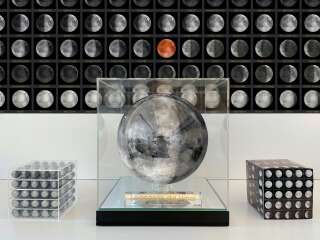
NASA's IM-1 mission will leave an unexpected gift on the moon

Intuitive machine
The Nova-C lander developed by the American company Strat-up Intuitive Machine should be sent to the Moon
Space – After the failure of Astrobotic Technology's Peregrine mission at the beginning of January, another American startup is trying its luck at returning to the moon. Intuitive Machine is scheduled to launch its Nova-C lander on Wednesday, February 14. The latter will transport many scientific instruments for NASA… but it will also transport works by Jeff Koons that need to be placed on the Moon.
The launch is scheduled to take place at 6:15 a.m. (Paris time) from Kennedy Space Center in Florida. The IM-1 mission (for “Intuitive Machines Mission 1”) must be launched on a SpaceX rocket to reach the South Pole of the Moon, after the success of the Japanese SLIM mission.

The Intuitive Mission is part of NASA's CLPS program, which funds private companies to carry out missions at their own expense. A contract worth over $100 million has been concluded with Intuitive Machine. If successful, this mission will mark the United States' return to our natural satellite after more than 50 years of absence.
It is an opportunity that Jeff Koons did not want to miss, as he created 125 miniature moon sculptures for the occasion. Each of them represents a phase of the Earth's satellite.

Jeff Koons/Pace Gallery
125 Jeff Koons sculptures representing the different phases of the moon
The race to the south pole of the moon
At the time of the Apollo program, NASA was always targeting the Moon's equatorial region, which was technically less dangerous. But the discovery of icy water in the Antarctic region has raised the challenges facing future space missions.

It is possible that this water will become necessary, especially as part of the American Artemis program, which plans to return astronauts to the moon. The long-term goal is to make the Moon a space base so astronauts can go to Mars.
But before we get there, we'll have to understand the lunar environment. One of the difficulties is the lack of an atmosphere, so landing on the moon must be done using propulsion devices. This is while the Antarctic environment is more hostile than the tropical region
“You have to realize that when you are near the South Pole, communication with the Earth is more complicated, because you see the Earth almost flat on the horizon. So there may be a communication breakdown and you have to be careful not to lose communication.”“Explains Patrick Bennett, director of research at the National Center for Scientific Research.
Moreover, the mission will last only seven days, before being interrupted by lunar night. During this time temperatures can drop to -170°C in Antarctica. Therefore, it will be difficult for the instruments to withstand such extremes.
See also on HuffPost :

“Organizer. Social media geek. General communicator. Bacon scholar. Proud pop culture trailblazer.”
